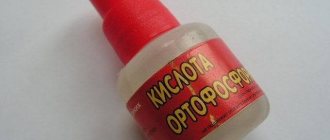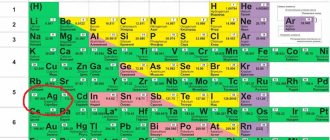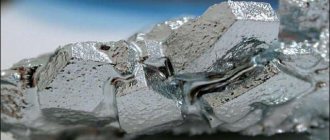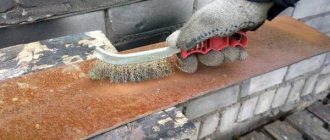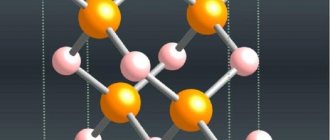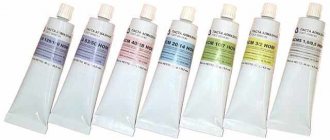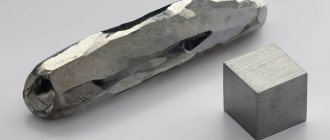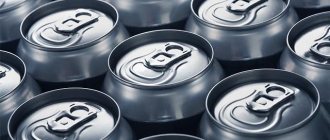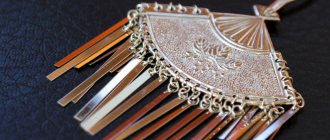Corrosion of a metal in acids is its destruction when interacting with concentrated or diluted acids. Such destruction often occurs in chemical production and other areas of human activity. Even some foods can create weak acidic solutions, and uncoated metal that comes into contact with them will corrode. How a metal object behaves when in contact with acid depends on its ability to passivate. The process of corrosion of metals in acids occurs with the release of hydrogen.
Let us consider in more detail cases of metal corrosion in acids of different origins.
Corrosion of metals in hydrochloric acid
Hydrochloric acid is very aggressive towards metals. This is largely due to the content of Cl- ions in it. Even corrosion-resistant steels are susceptible to failure when the acid concentration is higher than average. If the solution is diluted sufficiently, such steels do not corrode.
Corrosion of nickel in sulfuric acid does not occur even when the boiling point is reached. In the presence of ferric iron, chlorides, and other oxidizing agents, nickel and its alloys begin to deteriorate.
Low-alloy austenitic steel at room temperature and a hydrochloric acid concentration of 0.2 - 1% undergoes corrosion at a rate of 24 g/(m2•day).
Hydrofluoric acid price
The price of the reagent depends on its purity and concentration. Typically, 40, 60 and 70 percent hydrogen fluoride solutions are available. From the point of view of purity, acid is divided into technical and ordinary. The latter 70 percent solution, for example, costs around 210-250 rubles per kilogram.
The technical version of the reagent is usually 40 percent. They give 35-60 rubles per kilogram. Not everyone delivers from one kilo. Most manufacturers work only with wholesalers.
In this case, the price tag decreases. You can buy 70% hydrofluoric acid for 170 rubles per kilo. In addition to the standard ones, there are offers, for example, 85 percent acid. This is supplied mainly from China.
Some Russian enterprises are also ready to process non-standard orders for large volumes of purchases.
Corrosion of metals in organic acids
The strongest among organic acids is acetic acid. In malic, benzoic, picric, oleic, tartaric, and stearic acids, corrosion-resistant steels are highly resistant even at high temperatures (above 100°C). When metals come into contact with formic acid, pitting occurs (especially as the temperature increases). Their depth is even greater than in acetic acid.
Aluminum is highly resistant to organic acids because There is a protective film of sparingly soluble oxides on its surface.
Oxalic, sebacic, citric and lactic acids cause corrosion of steel only at high concentrations. They are resistant to chromium steels with molybdenum additives.
Corrosion of metals in nitric acid
Nitric acid is aggressive towards many metals. Low-carbon steels do not have sufficient stability in nitric acid solutions. In addition, when the HNO3 concentration increases to 35–40% (at these concentrations, the steel goes into a passive state), the corrosion of low-carbon steels in nitric acid increases. When the concentration of nitric acid is close to 100%, the passive state is broken. Nitric acid is an oxidizing agent. During iron corrosion, the cathodic depolarizers are nitric acid molecules and nitrate ions. The stability of chromium steels in nitric acid increases if nickel and molybdenum are added to their composition. Corrosive destruction of steels in nitric acid occurs along grain boundaries. Aluminum is slightly affected by nitric acid vapors or solutions with a concentration of more than 80%. At normal temperatures, aluminum is highly resistant to corrosion in nitric acid. The corrosion rate of aluminum in nitric acid increases with constant stirring and the presence of chloride ions in the solution.
Nitric acid
Nitric acid
- a colorless liquid with a pungent odor, density 1.52 g/cm3, boiling point 84°C, at a temperature of -41°C it hardens into a colorless crystalline substance. Typically used in practice, concentrated nitric acid contains 65 - 70% HNO3 (maximum density 1.4 g/cm3); Acid mixes with water in any ratio. There is also fuming nitric acid with a concentration of 97 - 99%.
Nitric acid
high concentrations release gases in air, which in a closed bottle are detected in the form of brown vapors (nitrogen oxides). These gases are very poisonous, so you need to be careful not to inhale them. Nitric acid oxidizes many organic substances. Paper and fabrics are destroyed due to the oxidation of the substances that form these materials. Concentrated nitric acid causes severe burns with prolonged contact and yellowing of the skin for several days with short contact. Yellowing of the skin indicates the destruction of protein and the release of sulfur (a qualitative reaction to concentrated nitric acid - yellow coloring due to the release of elemental sulfur when the acid acts on protein - xanthoprotein reaction). That is, it is a skin burn.
To prevent burns, you should work with concentrated nitric acid while wearing rubber gloves. At the same time, handling nitric acid is less dangerous than, for example, sulfuric acid; it evaporates quickly and does not remain in unexpected places. Splashes of nitric acid should be washed off with plenty of water, or even better, moistened with a soda solution.
Fuming nitric acid, when stored under the influence of heat and light, partially decomposes:
4HNO3 = 2H2O + 4NO2 + O2.
The higher the temperature and the more concentrated the acid, the faster the decomposition occurs. Therefore, store it in a cool and dark place. The released nitrogen dioxide dissolves in the acid and gives it a brown color.
Dilute acid can be easily prepared by pouring concentrated acid into water.
Dilute nitric acid is stored and transported in chromium steel containers, concentrated - in aluminum containers, because concentrated acid passivates aluminum, iron and chromium due to the formation of insoluble oxide films:
2Al + 6HNO3 = Al2O3 + 6NO2 + 3H2O.
Small quantities are stored in glass bottles. Nitric acid strongly corrodes rubber. Therefore, bottles must have ground or polyethylene stoppers.
Nitric acid is used mainly in the form of aqueous solutions; it is one of the components of aqua regia and is found in assay acids. In industry, it is used to produce combined nitrogen fertilizers, for dissolving ores and concentrates, in the production of sulfuric acid, various organic nitroproducts, in rocket technology as a fuel oxidizer, etc.
Industrial production of nitric acid
Modern industrial methods for producing nitric acid are based on the catalytic oxidation of ammonia with atmospheric oxygen. When describing the properties of ammonia, it was indicated that it burns in oxygen, and the reaction products are water and free nitrogen. But in the presence of catalysts, the oxidation of ammonia with oxygen can proceed differently.
If a mixture of ammonia and air is passed over a catalyst, then at 750 °C and a certain composition of the mixture, almost complete conversion occurs
The resulting NO easily transforms into NO2, which, with water in the presence of atmospheric oxygen, produces nitric acid.
Platinum-based alloys are used as catalysts for the oxidation of ammonia. The nitric acid obtained by the oxidation of ammonia has a concentration not exceeding 60%. If necessary, it is concentrated. The industry produces diluted nitric acid with a concentration of 55, 47 and 45%, and concentrated nitric acid - 98 and 97%,
Application of nitric acid
Nitric acid is used in the production of nitrogen and combined fertilizers (sodium, ammonium, calcium and potassium nitrate, nitrophos, nitrophoska), various sulfuric acid salts, explosives (trinitrotoluene, etc.), organic dyes.
In organic synthesis, a mixture of concentrated nitric acid and sulfuric acid—a “nitrating mixture”—is widely used.
In metallurgy, nitric acid is used to dissolve and pickle metals, as well as to separate gold and silver. Nitric acid is also used in the chemical industry, in the production of explosives, and in the production of intermediates for the production of synthetic dyes and other chemicals.
Technical nitric acid is used for nickel plating, galvanizing and chrome plating of parts, as well as in the printing industry. Nitric acid is widely used in the dairy and electrical industries.
Density of solutions of different concentrations of nitric acid
| Density, g/cm3 | Concentration | Density, g/cm3 | Concentration | ||
| % | g/l. | % | g/l. | ||
| 1, 000 | 0, 3296 | 3, 295 | 1, 285 | 46, 06 | 591, 9 |
| 1, 005 | 1, 255 | 12, 61 | 1, 290 | 46, 85 | 604, 3 |
| 1, 010 | 2, 164 | 21, 85 | 1, 295 | 47, 63 | 616, 8 |
| 1, 015 | 3, 073 | 31, 19 | 1, 300 | 48, 42 | 629, 5 |
| 1, 020 | 3, 982 | 40, 61 | 1, 305 | 49, 21 | 642, 1 |
| 1, 025 | 4, 883 | 50, 05 | 1, 310 | 50, 00 | 644, 7 |
| 1, 030 | 5, 784 | 59, 57 | 1, 315 | 50, 85 | 668, 5 |
| 1, 035 | 6, 661 | 68, 93 | 1, 320 | 51, 71 | 682, 4 |
| 1, 040 | 7, 530 | 78, 32 | 1, 325 | 52, 56 | 696, 3 |
| 1, 045 | 8, 398 | 87, 77 | 1, 330 | 53, 41 | 710, 1 |
| 1, 050 | 9, 259 | 97, 22 | 1, 335 | 54, 27 | 724, 0 |
| 1, 055 | 10, 12 | 106, 7 | 1, 340 | 55, 13 | 738, 5 |
| 1, 060 | 10, 97 | 116, 3 | 1, 345 | 56, 04 | 753, 6 |
| 1, 065 | 11, 81 | 125, 8 | 1, 350 | 56, 95 | 768, 7 |
| 1, 070 | 12, 65 | 135, 3 | 1, 355 | 57, 87 | 783, 8 |
| 1, 075 | 13, 48 | 145, 0 | 1, 360 | 58, 78 | 799, 0 |
| 1, 080 | 14, 31 | 154, 6 | 1, 365 | 59, 69 | 814, 7 |
| 1, 085 | 15, 13 | 164, 1 | 1, 370 | 60, 67 | 831, 1 |
| 1, 090 | 15, 95 | 173, 8 | 1, 375 | 61, 69 | 848, 1 |
| 1, 095 | 16, 76 | 183, 5 | 1, 380 | 62, 70 | 865, 1 |
| 1, 100 | 17, 58 | 193, 3 | 1, 385 | 63, 72 | 882, 8 |
| 1, 105 | 18, 39 | 203, 1 | 1, 390 | 64, 74 | 900, 4 |
| 1, 110 | 19, 19 | 213, 0 | 1, 395 | 65, 84 | 918, 1 |
| 1, 115 | 20, 00 | 223, 0 | 1, 400 | 66, 97 | 937, 6 |
| 1, 120 | 20, 79 | 232, 9 | 1, 405 | 68, 10 | 956, 6 |
| 1, 125 | 21, 59 | 242, 8 | 1, 410 | 69, 23 | 976, 0 |
| 1, 130 | 22, 38 | 252, 8 | 1, 415 | 70, 34 | 996, 2 |
| 1, 135 | 23, 16 | 262, 8 | 1, 420 | 71, 63 | 1017 |
| 1, 140 | 23, 94 | 272, 8 | 1, 425 | 72, 86 | 1038 |
| 1, 145 | 24, 71 | 282, 9 | 1, 430 | 74, 09 | 1059 |
| 1, 150 | 25, 48 | 292, 9 | 1, 435 | 74, 35 | 1081 |
| 1, 155 | 26, 24 | 303, 1 | 1, 440 | 76, 71 | 1105 |
| 1, 160 | 27, 00 | 313, 2 | 1, 445 | 78, 07 | 1128 |
| 1, 165 | 27, 26 | 323, 4 | 1, 450 | 79, 43 | 1152 |
| 1, 170 | 28, 51 | 333, 5 | 1, 455 | 80, 88 | 1177 |
| 1, 175 | 29, 25 | 343, 7 | 1, 460 | 82, 39 | 1203 |
| 1, 180 | 30, 00 | 354, 0 | 1, 465 | 83, 91 | 1229 |
| 1, 185 | 30, 74 | 364, 2 | 1, 470 | 8550 | 1257 |
| 1, 190 | 31, 47 | 374, 5 | 1, 475 | 87, 29 | 1287 |
| 1, 195 | 32, 21 | 385, 0 | 1, 480 | 89, 07 | 1318 |
| 1, 200 | 32, 94 | 395, 3 | 1, 485 | 91, 13 | 1353 |
| 1, 205 | 33, 68 | 405, 8 | 1, 490 | 93, 19 | 1393 |
| 1, 210 | 34, 41 | 416, 3 | 1, 495 | 95, 46 | 1427 |
| 1, 215 | 35, 16 | 427, 1 | 1, 500 | 96, 73 | 1450 |
| 1, 220 | 35, 93 | 438, 3 | 1, 501 | 96, 98 | 1456 |
| 1, 225 | 36, 70 | 449, 6 | 1, 502 | 97, 23 | 1461 |
| 1, 230 | 37, 48 | 460, 9 | 1, 503 | 97, 49 | 1465 |
| 1, 235 | 38, 25 | 472, 4 | 1, 504 | 97, 74 | 1470 |
| 1, 240 | 39, 02 | 483, 8 | 1, 505 | 97, 99 | 1474 |
| 1, 245 | 39, 80 | 495, 5 | 1, 506 | 98, 25 | 1479 |
| 1, 250 | 40, 58 | 505, 2 | 1, 507 | 98, 50 | 1485 |
| 1, 255 | 41, 36 | 519, 0 | 1, 508 | 98, 76 | 1490 |
| 1, 260 | 42, 14 | 530, 9 | 1, 509 | 99, 01 | 1494 |
| 1, 265 | 42, 92 | 542, 9 | 1, 510 | 99, 26 | 1499 |
| 1, 270 | 43, 70 | 555, 0 | 1, 511 | 99, 52 | 1503 |
| 1, 275 | 44, 48 | 567, 2 | 1, 512 | 99, 74 | 1508 |
| 1, 280 | 45, 27 | 579, 4 | 1, 513 | 100, 00 | 1513 |
Corrosion of metals in sulfuric acid
At a sulfuric acid concentration of about 50–55%, the iron surface becomes passive. Further, with an increase in temperature and concentration of sulfuric acid, the surface of the iron becomes active (corrosion of iron in sulfuric acid is observed).
In solutions of sulfuric acid, as in other acids, the rate of corrosion of iron is greatly influenced by the nature of the anions. This is due to the inhibition of the cathodic and anodic processes and their adsorption on the metal surface.
Ya.M. Kolotyrkin developed the idea that anions influence the anodic dissolution of iron. This is due to the formation of the complex:
Fe + H2O ↔ Fe(OH-)ads. +H+;
Fe(OH-)ads ↔ Fe(OH)ads + e-;
Fe(OH)ads + HSO4- →FeSO4 + H2O + e-;
Fe(OH)ads + SO42- → FeSO4 + OH- + e-;
FeSO4 = Fe2+ + SO42-.
From the above equations it is clear that the rate of the anodic process increases with increasing concentration of HSO4- and SO42- ions. From the surface of iron, sulfate ions are replaced by chloride ions, but up to a certain concentration of chlorine ions, the rate of the anodic process slows down.
In 95 - 98% sulfuric acid at normal temperatures, chromium steels (with a chromium content of about 17%) with a small addition of molybdenum or without it have good resistance. Under such conditions (at a high concentration of sulfuric acid), aluminum and carbon steels are also resistant. Pure aluminum (99.5%) is more stable in sulfuric acid than its alloys, which do not contain copper. The corrosion rate of aluminum in sulfuric acid (and its alloys) with an increase in temperature from 20°C to 98°C increases from 8 to 24 g/(m2•day). Corrosion-resistant steels in a 5 or 20% solution at the boiling point of sulfuric acid are stable only in the presence of corrosion inhibitors.
At ordinary temperatures in sulfuric acid, copper corrosion is practically not observed. And when the temperature rises to 100°C, the destruction process intensifies. In a 25% sulfuric acid solution, high pressure and a temperature close to 200°C, copper quickly breaks down.
Brass does not have corrosion resistance in solutions of sulfuric acid of any concentration, even at room temperature. The resistance of brass to destruction in sulfuric acid can only be increased by introducing 30% CuSO4•5H2O salt into the solution.
Nitric acid (HNO3)
It is a very strong acid with a pungent odor.
Pros:
- Dissolves all metals except aluminum and iron.
- Low price. From 15 rub. per kilogram for technical and from 50 rubles. for pure acid.
- Prevalence - you can buy nitric acid in any city, in many online stores, in all volumes and concentrations.
- Multifunctionality. This compound is also used as a rocket fuel reagent, fertilizer and raw material for medicines (nitroglycerin).
Minuses:
- Volatility of nitric acid. The concentrated compound “smoke”, and in bright light it decomposes into nitric oxide and water. It should be stored in dark containers.
- Suffocating smell.
- Virulence. Acid is dangerous for the human body, causing suffocation and intoxication if exposed to unprotected contact. You need to work with it wearing a mask and gloves.
- Slow action. If the compound is not mixed with other acids, then 2 mm of metal will dissolve in 5 hours.
- Dissolving not only the desired object, but also the surrounding objects - concrete, wood, etc.
Corrosion of metals in phosphoric acid
Molybdenum steels are characterized by the greatest resistance to corrosion in phosphoric acid. Aluminum and its alloys (which do not contain copper or magnesium) are stable in phosphoric acid. At ordinary temperatures, chromium-nickel austenitic steels are also indestructible (in solutions of phosphoric acid of any concentration). In concentrated technical phosphoric acid at a temperature not exceeding 50°C, low-carbon steels are resistant. If steel with 17% chromium is placed in a phosphoric acid solution with a concentration of 1 to 10%, then it will be highly resistant even at boiling point.
Copper is practically not subject to corrosion in phosphoric acid at temperatures from 20 to 95°C. But if an oxidizing agent is introduced into the system and the temperature is increased, the rate of corrosion of copper in phosphoric acid increases significantly. Bronze and brass behave similarly in phosphoric acid.
Hydrofluoric acid and metals
When we talk about hydrofluoric acid, we usually talk about interaction with glass and silicates, less often about a mixture of hydrofluoric and nitric acids, which is used, for example, for etching silicon or transferring metals such as tungsten and tantalum into solution.
However, hydrofluoric acid is not only a unique acid that reacts with glass or easily dissolves titanium. It is a typical representative of the acid class. It would be interesting to try how hydrofluoric acid reacts with ordinary metals. Hydrofluoric acid is a medium-strength acid, so it should be expected to react less actively than hydrochloric or dilute sulfuric acid (at least where complexation of the metal cation with the acid anion does not play a decisive role).
For the first experiment we used zinc, aluminum and iron. Zinc and aluminum were in the form of granules (reagents of analytical grade); instead of pure iron, they used a nail and a bolt made of black steel. The metals were placed in polypropylene tubes and filled with 40% hydrofluoric acid. For comparison, a test tube with zinc was placed next to it, into which concentrated hydrochloric acid was poured.
In the first test tube (zinc and hydrofluoric acid), a slow evolution of gas was observed - it was significantly weaker than in the case of zinc and hydrochloric or dilute sulfuric acids. The solution remained transparent throughout the entire experiment (15 minutes).
In the second test tube (aluminum and hydrofluoric acid), the gas evolution was even weaker. The solution quickly became white and cloudy: it turns out that aluminum fluoride is slightly soluble in water. It is more soluble in solutions of hydrofluoric acid, but still weakly.
In the third test tube (iron and hydrofluoric acid), the release of gas was weak, but quite distinct. No solid phase was formed.
But in the fourth test tube (which contained concentrated hydrochloric acid and zinc), the solution literally boiled: active evolution of hydrogen was observed, white smoke came from the test tube (hydrogen chloride evaporated and formed a fog of hydrochloric acid in the air), splashes and drops of condensate settled on the walls. The liquid became very hot. Just a few minutes later the reaction slowed down significantly: almost all the hydrochloric acid was consumed. The solution became white and cloudy. Zinc chloride is very soluble in water, but apparently so much of it was formed that a precipitate began to form (in addition, the solubility of zinc chloride in hydrochloric acid can be much lower than in water).
When we added a new portion of hydrochloric acid to the fourth test tube, the “boiling” resumed.
A rather interesting fact was observed after the experiment - while washing dishes. When the contents of test tubes No. 1 and 2 (fluoric acid along with zinc and aluminum granules) were poured into a polypropylene glass and diluted with water, the gas evolution did not weaken, but intensified. This prompted the idea of conducting an experiment, which will be described in the next part of the article.
Watch the video
(43 MB, .avi)
